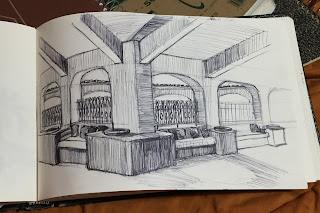Reflections of an Art Student ( 4 of 4)
Enter the “critique”, where everyone lines up their work in front of the class for everyone else to see…and evaluate. Then one by one each artist is identified with their work, the professor makes observations and recommendations and the rest of the class is able to contribute their input. There is a give and take in the conversation, an exchange of ideas. My guess is that this is still the way art classes work, because, at it’s best, it is a very productive way to learn and grow. It can also be very emotional.
At turns the “crit” can be exhilarating and humiliating, discouraging and encouraging, positive and negative, and all together draining. When students in other fields get back a marked up paper or a test with an unexpected grade, they have the luxury of a private moment to deal with whatever emotions this feedback churns up. Not so the art student. This is a very public experience.
In those awkward critiques where someone’s work was being picked apart, peers challenging choices with questions like “Why did you do this?” or “Why didn’t you include that?”, I noticed that there were two ways people usually responded. The first is summed up in the words: “I wanted it that way.” From this we could conclude that, whether or not a conscious decision was made, the person was fine with the end product and had no interest in considering other options. End of discussion. And end of the learning opportunity.
Of course, there is helpful criticism that builds people up and criticism that is destructive and holds them back. Remember the listener is always at liberty to pick and choose what influences and informs his choices. The question is: how do you receive feedback on your work?
A Visual Travel Journal
Enter the “critique”, where everyone lines up their work in front of the class for everyone else to see…and evaluate. Then one by one each artist is identified with their work, the professor makes observations and recommendations and the rest of the class is able to contribute their input. There is a give and take in the conversation, an exchange of ideas. My guess is that this is still the way art classes work, because, at it’s best, it is a very productive way to learn and grow. It can also be very emotional.
At turns the “crit” can be exhilarating and humiliating, discouraging and encouraging, positive and negative, and all together draining. When students in other fields get back a marked up paper or a test with an unexpected grade, they have the luxury of a private moment to deal with whatever emotions this feedback churns up. Not so the art student. This is a very public experience.
In those awkward critiques where someone’s work was being picked apart, peers challenging choices with questions like “Why did you do this?” or “Why didn’t you include that?”, I noticed that there were two ways people usually responded. The first is summed up in the words: “I wanted it that way.” From this we could conclude that, whether or not a conscious decision was made, the person was fine with the end product and had no interest in considering other options. End of discussion. And end of the learning opportunity.
The second reaction to feedback was: “I hadn’t thought of
that!” Behind this statement was an open thought and a humble willingness to hear ideas, a readiness to
reconsider choices with the aim to bring new light to the next project. Deeper analysis and
constructive criticism could flow freely in a non-judgmental, impersonal way…
very productive. Note that, with this attitude of thought the art work itself
becomes less precious than the insights that can be gained from it to make one
a better artist. This is why my professor could confidently say that most of our work would be garbage at the end of the year; the lessons were learned.
Of course, there is helpful criticism that builds people up and criticism that is destructive and holds them back. Remember the listener is always at liberty to pick and choose what influences and informs his choices. The question is: how do you receive feedback on your work?






Comments
Post a Comment